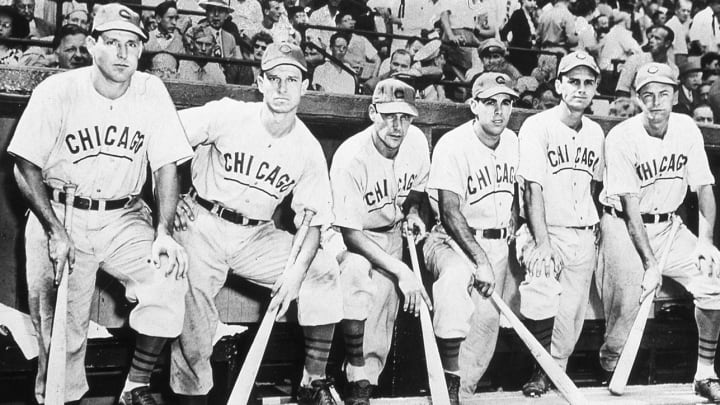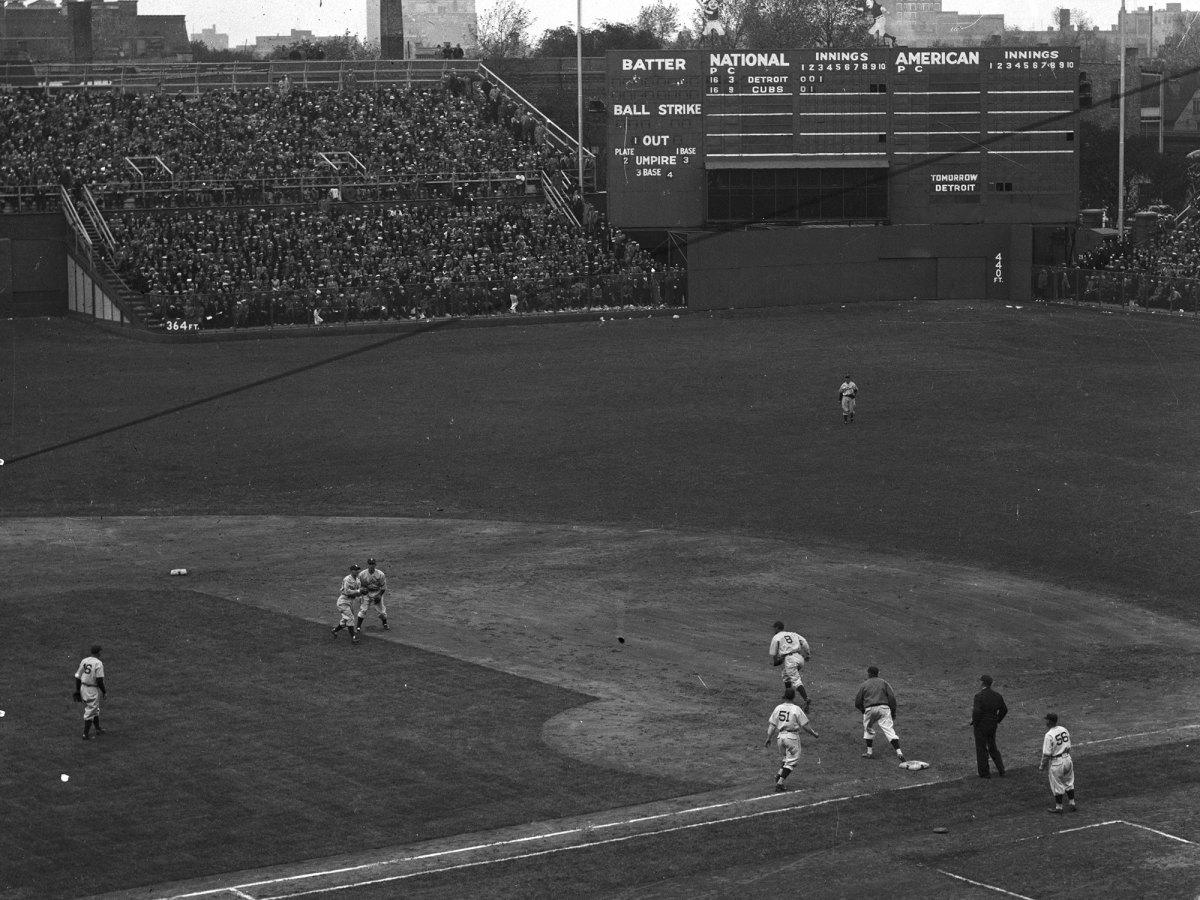To win World Series, Cubs must reverse history of Wrigley Field in Fall Classic

Watch Game 3 of the 2016 World Series live on Fox or stream it on Fox Sports Go by clicking here.
For the first time in 71 years, there will be a World Series Game played at Wrigley Field on Friday night. The home of the Cubs since 1916, Wrigley once saw plenty of Fall Classic action, but Chicago’s long pennant-less streak has rendered the Friendly Confines an October afterthought since the end of World War II.
But on Friday the spotlight—and the floodlights, which were installed at the ballpark at Waveland and Sheffield avenues in 1988, the 43rd season of their pennant drought—will be squarely on Wrigley when the Cubs host the Indians with the Series tied at one-game apiece. It will be the first televised World Series game in the ballpark's history, but more importantly it will also be an opportunity to reverse some of the awful results the team has had at home in the Fall Classic. Here's the brief history of World Series games at Wrigley Field:
1929
The first World Series game played at Wrigley Field didn’t come until 1929, 15 years after the ballpark opened as the home of a Federal League team. Not that Chicago hadn’t had an earlier opportunity: The 1918 Cubs team that faced the Red Sox in that year’s Fall Classic played its home games at Comiskey Park, the home of the White Sox, because Comiskey could hold more fans. Nonetheless, 1929 looked like as good a year as any for Cubs fans to watch their team break a 21-year championship drought, as Chicago won 98 games to blow away the rest of the National League and earn a World Series berth opposite the powerhouse Philadelphia Athletics.
The Series opened at Wrigley in front of 50,470 fans, with A’s manager Connie Mack surprising everyone by starting 35-year-old Howard Ehmke—who had thrown only 55 innings all season—instead of aces Lefty Grove or Rube Walberg. The gamble paid off: The soft-tossing, sidearming Ehmke flummoxed the Cubs, striking out a then-Series-record 13 batters in a complete-game win as Philadelphia took Game 1, 3–1. Game 2 was no better, with the A’s jumping to a 6–0 lead in the first four innings and holding on for a 9–3 victory.
At the very least, Cubs fans didn’t have to endure the humiliation of Game 4, which came at Philadelphia’s Shibe Park, as Chicago blew an 8–0 lead by giving up 10 runs in the seventh—still a World Series record—that included an inside-the-park home run by Mule Haas on a fly ball dropped by centerfielder Hack Wilson. A Chicago win would have evened the series; instead, the Cubs lost Game 4, then saw their title hopes come to an end in Game 5 as Walberg finished them off in relief of Ehmke.
Joe Buck: Why calling World Series at Wrigley Field will be my career highlight
1932
It didn’t take long for the Windy City to host another World Series, as the 1932 Cubs earned their second pennant in four seasons by winning 90 games. All that got them, though, was a matchup with a juggernaut New York Yankees team that had won 107 games and demolished the American League, winning the pennant by 13 games. The Fall Classic wasn’t close either: New York took the first two games at Yankee Stadium, then finished the sweep by winning Games 3 and 4 at Wrigley before crowds listed for both games at just under 50,000.
Of course, a lot more people have claimed they were at Game 3. With the score tied at 4–4 in the fifth, Babe Ruth came to the plate having already hit a three-run homer in the first. Ruth and the Cubs’ bench had been barking at each other all game, and after strike one from pitcher Charlie Root, the heckling got louder. Ruth’s response was to point his bat, allegedly in the direction of centerfield, which he did again after strike two. The third pitch ended up 440 feet away from home plate in the centerfield bleachers for Ruth’s second home run of the day—one that would go down as his famous Called Shot.
Whether or not Ruth actually called his home run is fiercely debated to this day; what’s not is the fact that he and teammate Lou Gehrig (who went 9-for-17 with three home runs) singlehandedly dismantled Chicago. Through two World Series, Wrigley Field had yet to see the Cubs win a game.

1935
Once again, Cubs fans weren’t left waiting long for another crack at a World Series. The 1935 Chicago squad was one of the best in franchise history, winning 100 games (the first time the Cubs had done so since 1910) and 21 straight in September to hold off the Cardinals and clinch the pennant. Boasting one of baseball’s best offenses and a dynamite young pitching staff, Chicago rode into the Fall Classic against the AL champion Tigers hoping to end its 27-year title drought.
Things looked good through the first two games in Detroit, with the Cubs winning Game 1 on a complete-game shutout by Lon Warneke and, despite losing Game 2, seeing superstar Tigers first baseman Hank Greenberg suffer a broken wrist that knocked him out for the rest of the series. But the momentum didn’t last. In front of the home fans at Wrigley in Game 3, the Cubs scored two in the ninth to tie things at five but lost in the 11th. In Game 4, Detroit’s Alvin “General” Crowder shut Chicago down in a complete-game win, allowing just one run on five hits in a tense 2–1 affair that saw the Cubs put two on in the ninth with one out but fail to score.
Chicago avoided elimination and won its first ever World Series game at Wrigley in Game 5 thanks to a two-run homer from Chuck Klein and another strong outing from Warneke. The end came in Game 6. Tied at three in the ninth at Detroit’s Navin Field, the Cubs' Stan Hack led off the ninth with a triple but was stranded there. It didn’t take long for Chicago to pay for that, as Tigers leftfielder Goose Goslin won the game and the series with a walk-off single in the bottom of the frame off Larry French.
Cheer for Chapman? One fan's effort to support the Cubs and stop domestic violence
1938
The Cubs kept up their “every three years” pennant run, this time barely edging out the Pirates in the season’s final week. Chicago’s reward: Another World Series date with the Yankees, who once again swept their way to the title. The Cubs scored just nine runs in their four contests, dropping Games 1 and 2 at Wrigley to run the franchise’s World Series record in the Friendly Confines to 1–9.
Game 2 of the series carried a particular melancholy, as staff ace Dizzy Dean blew a 3–2 lead in the top of the eighth on a two-run homer by Frankie Crosetti—an outing that would become known as “Ol’ Diz’s Last Stand.” Dean, whose pitching delivery and stuff had been altered by a broken toe suffered in the 1937 All-Star Game, had helped carry the Cubs to the '38 pennant but was a shell of himself afterward, washing out of baseball in ’41.
1945
After 1938, the Cubs fell into a short yet brutal stretch of poor results, finishing fourth or worst for six straight seasons. In 1945, however, Chicago stunned the NL by winning 98 games and its 10th pennant. Once again, the Cubs faced the Tigers in the World Series, though both teams were still missing players who had joined the military during World War II.
The war had also led MLB to alter the setup of its series, with the Tigers hosting the first three games before the Fall Classic moved to Chicago for the rest of the action. The Cubs made the most of their stay in Detroit, beating Tigers ace Hal Newhouser in Game 1 and taking Game 3 on a complete-game–one-hitter by Claude Passeau to head to Wrigley with a 2–1 series lead. But Game 4 was where everything turned, both literally and metaphysically. On the field, Detroit’s Dizzy Trout shut the Cubs down with a complete-game win, allowing only one run on five hits. In the stands came what will forever be known as the Curse of the Billy Goat, as local bar owner and Cubs fan Billy Sianis—irate over being asked to leave the game due to the odiferous presence of his pet goat—supposedly hexed the team by declaring, “Them Cubs, they ain’t gonna win no more.”
He was almost right. Chicago dropped Game 5 but staved off elimination in Game 6 before collapsing in Game 7, giving up five runs in the first as Newhouser shut the Cubs down to win the series. To date, that has been the last World Series game played at Wrigley; the team’s record at home in the Fall Classic is a miserable 2–12.
